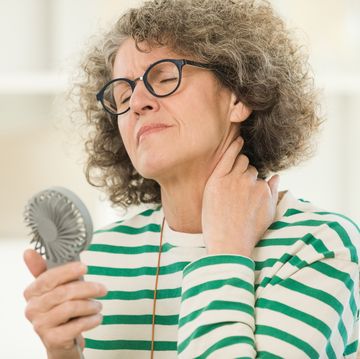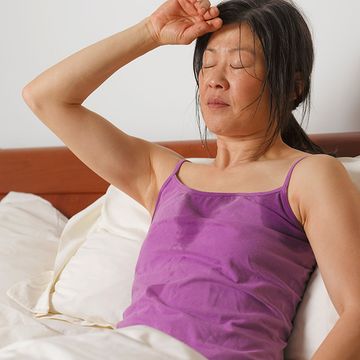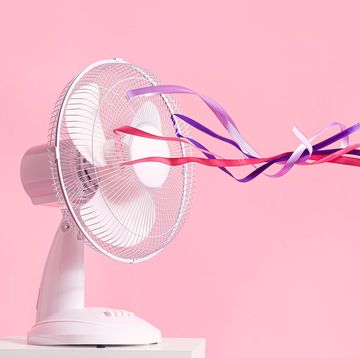Roxy Finn*, 47, first noticed her hair body was thinning in her 20s, but it's gotten worse in the past few years. "It's one of the most devastating things I've ever had to face," she says. "Women are supposed to have thick, sexy hair, so it's a big chunk of your sexiness down the drain—literally!" Initially, Finn thought the thinning might have been due to perming her hair, but after consulting her primary care doctor, gynecologist, and dermatologist, she learned that the real problem is a genetic predisposition to hair loss in women. Put simply, her hair is no longer growing in as thick or as long as it did when she was younger.
Finn is not alone, as 50% of women experience some kind of hair loss by age 50. "It's far more common than people realize," says Robert Leonard, DO, founder of Leonard Hair Transplant Associates in Cranston, RI. But even though the problem is widespread, it's only now that help is more readily available.
"More women in my practice are addressing this condition," says Mary Gail Mercurio, MD, an associate professor of dermatology and obstetrics and gynecology at the University of Rochester. "That's encouraging, because the sooner hair loss is diagnosed, the better the chances of finding its cause and successfully treating it."
*Name has been changed
The root cause of hair loss in women
"We all shed around one hundred to one hundred fifty hairs per day," says Paradi Mirmirani, MD, a dermatologist in Vallejo, CA, who specializes in hair disorders. But if you're losing more than that (you can tell if you see clumps of hair in the shower drain), your part is getting wider, or your hair has become significantly finer, you may be dealing with female pattern hair loss, a genetic condition that affects 30 million American women. Although FPHL (also called androgenetic alopecia) can begin as early as your 20s, it's most common after menopause. "Multiple genes play a role, and they have an equal probability of being inherited from your mother's or father's side," explains Dr. Mercurio.
Although this type of hair loss doesn't necessarily indicate a medical issue, you should consult your GP to rule out a thyroid problem, iron deficiency anemia, or an excessive level of male hormones (common when you have polycystic ovarian syndrome or when estrogen levels drop off around menopause); these conditions may cause a different type of hair loss or aggravate FPHL if left untreated.
If your doctor determines that you don't have these other, more serious health issues, or resolving them doesn't minimize symptoms, your next stop is the dermatologist's office. She will perform a scalp exam and take a detailed medical and family history to determine why your hair is thinning and help you develop a treatment plan.
[header=Natural treatments for hair loss]
Natural hair loss treatments
Although you can't change your genes, there are some things you can do to protect the hair you have. But think lifestyle changes—not hope in a jar.
DIET DOS: If you're vegetarian or anemic, you may lack adequate iron, which is essential for strong, healthy hair. Make sure you're eating plenty of leafy greens—such as spinach, kale, and chard—and beans, tofu, or lean cuts of red meat, which are all great sources of iron as well as biotin and zinc, two nutrients that may also play a role in hair growth.
SCALP MASSAGE: Many pros suggest scalp massage for clients with thinning hair. "Use your fingertips and a bit of argan or coconut oil to rub in a circular motion for several minutes before you shampoo," says John Masters, owner of John Masters Organic Salon. Mary Lupo, MD, a clinical professor of dermatology at Tulane Medical School and a Prevention medical advisory board member, says the theory is that massage temporarily increases circulation to the scalp, which may pump hair follicles with the nutrients needed for hair growth.
MORE: What Fabulous At 50 Looks Like
Medical hair loss treatments
Following a holistic approach that incorporates diet tweaks and other alternative therapies may thicken hair, but some women still need medical help to see significant regrowth.
OTC CURES: Currently, the best (and only FDA-approved) treatment for hair loss—no matter what its cause—is topical minoxidil, the drug used in Rogaine, an OTC treatment available in mousse or liquid formulas. "It's not clear exactly how minoxidil works, but studies show it lengthens the growth phase of your hair," says Dr. Leonard. Applying 2% minoxidil to the scalp twice daily has been shown to produce minimal regrowth in 40% of women and moderate regrowth in 19%; possible side effects include itching and redness of the scalp.
PRESCRIPTION REMEDIES: If you don't respond to minoxidil, your doctor might prescribe antiandrogen medications, which may slow hair loss and even stimulate growth in some women. "They inhibit male hormones that can exacerbate hair loss," explains Dr. Mirmirani. In select cases, she may prescribe finasteride, a 5-alpha reductase inhibitor, which blocks an enzyme that regulates the production of androgens. Because the medication causes birth defects, it is FDA approved only for men. "In premenopausal women who are no longer childbearing, finasteride can be used off label," Dr. Mirmirani notes.
MORE: 4 Gorgeous Hair Makeovers
Hair style tips for more body
Don't underestimate the importance of the right cut, color, and styling routine.
SWITCH YOUR PART: "Changing the direction of your part can really help thinning hair," says Nexxus Creative Director Kevin Mancuso. Hair tends to lie flatter against the scalp when brushed repeatedly in the same direction; if you typically part your hair on the left, flip it to the right, so it's more likely to stand away from your scalp and look more voluminous.
KEEP COOL: In general, the less heat you use, the better. "Styling with heat can damage the hair shaft," says Dr. Mirmirani. Air-dry whenever possible, and if you must use heated tools, pick those with adjustable settings and keep them on the lowest level. "This won't affect hair growth, but you'll see less of the breakage that makes hair look even thinner," Dr. Mirmirani says.
BRUSH WITH CARE: Used in conjunction with a blow-dryer, round metal brushes can heat up significantly, and some brushes with hard plastic or metal bristles can cause breakage, according to Angelo David, owner and creative director of New York City's Angelo David Salon. Instead, try a brush made of gentle boar bristles or flexible nylon.
GET A VOLUMIZING CUT: In most cases, shorter cuts are kinder to thinning hair. "The longer your hair grows, the more likely it is that sections will separate and reveal your scalp," explains Mancuso. Whatever length you choose, ask for interior layers, which are placed throughout your cut, not just on the ends, to add fullness.
COLOR STRATEGICALLY: Bleaching or significantly lightening your hair color all over can cause damage or breakage, but well-placed highlights hide thinning by making your hair color more similar to the color of your scalp. Plus, the dye expands the hair shaft slightly so it appears thicker, according to David.
MORE: At-Home Hair Color Tips

Virginia Sole-Smith is the author of The Eating Instinct: Food Culture, Body Image and Guilt in America, and writes the newsletter Burnt Toast.












